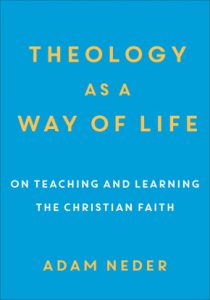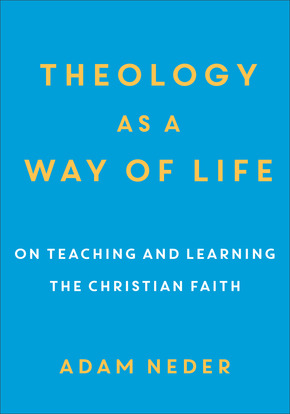Neder, Adam. Theology as a Way of Life: On Teaching and Learning the Christian Faith. Grand Rapids, MI: Baker Academic, 2019, pp. 176, $18.99, paperback.
Adam Neder is Bruner-Welch Professor of Theology at Whitworth University in Spokane, Washington. Neder offers readers a short, engaging, and wise book on the art of teaching the Christian faith.
Neder begins by urging teachers to move beyond communicating theological knowledge by guiding students to “exist in what one understands” (p. 4). In order to accomplish this task, Neder alerts his readers that he draws deeply upon the work of Barth (of whom this book began as a conference paper on Barth’s Evangelical Theology), Kierkegaard, and Bonhoeffer. Neder wants readers to know that he believes this book is useful not only for professors, but that connections for congregational ministry are “always just beneath the surface” (p. 9).
Following his introduction, Neder begins the second chapter by claiming: “Anthropology is the soul of pedagogy” (p. 15). He unpacks loaded claims such as this, but also peppers his book with enough unexplained nuggets to cause the reader to pause and think. This chapter provides the foundation for Neder’s philosophy of teaching: the art of teaching the Christian faith is bound to the doctrine of reconciliation. He believes, following Barth, that reconciliation is a reality that includes everyone, while “one’s subjective response to this objective reality is very important” (p. 23). Those unacquainted with Barthian reconciliatory nuance may struggle with Neder’s primary framing of theological pedagogy, but this obstacle can be overcome. Put more simply, and, perhaps, diluted from his intent, Neder argues that students are designed and prepared for a restored relationship with Jesus Christ. As such, theological education is germane for all students in a way that the study of chemistry is not.
Neder encourages teachers in his third chapter, “Knowledge,” to envision the practical implications of knowledge in life. He used to think that connecting lecture material to “real life” unserious and homiletical, but he now views this task as essential. Neder argues in his fourth chapter, titled “Ethos,” that the vice of theological educators is vanity. Neder explains that Barth understood a vain theologian as “an embodied contradiction of the gospel and the very antithesis of Jesus Christ himself” (p. 65). Neder reminds readers that Jesus told his followers to give up their possessions – for theologians this includes reputations. Neder aims for the ivory tower and pulpit jugulars, writing: “how easily we forget that every Christian leader profits off of Jesus Christ’s suffering and death. He gets crucified and we get paid. That’s the arrangement” (p. 76).
In the final two chapters, Neder explores the danger and type of conversations needed for theological education. He claims the subject matter of Christian theology demands a decision, and it demands a decision now. When we present and exist in the theology we profess, there should be unease, tension, and danger across the spectrum of taught classes. Neder explains that his current students prefer to listen and observe more than those of years ago. As such, teachers must work intentionally (and harder than before) to stimulate conversations. Conversations require improvisational unscripted dialogue, and are, therefore, risky. Neder advises teachers to not answer their own questions, but to let the wheels of their student’s minds turn in silence. In this sense, teachers step out of the way, even if just for five or ten seconds. He implores: “few pedagogical practices are more important than the skillful use of awkward silence” (p. 138).
Those who have stepped behind a lectern with any level of self-awareness are likely to identify with Neder’s overarching main idea: the responsibility to convey what must be said about God. It may be true that educators have some level of training in order to be teaching others, but when teaching about an infinite God, does it help all that much if the professor is one small step further down the academic road than his or her students? Yes, and no. In some strange way – yes, educators do have something to offer, they are placed in the classroom to bring to light what is already present in the hearts of students. Neder rightly challenges educators to move beyond effective information delivery. Educators must accept that their total effectiveness will usually be unknown beyond the length of the course.
Readers will not struggle to see why Neder has won multiple teaching awards at Whitworth. In Theology as a Way of Life, he demonstrates that if one delivers the content of the material for what it actually is (God), then it is a different kind of material, a different kind of “topic.” In this sense, educators are guaranteed to be humiliated because they will delve into discussions about the unknowable. They will invite risk into their classrooms. This is why Neder urges theological educators to believe that prayer is “the essential pedagogical practice” (p. 34).
Neder’s insights will resonate most with those who have taught theology in the classroom for at least a few years. He articulates what it feels like to teach theology. Newer teachers might be disappointed if they are looking for a list of practical teaching tips (though some are presented). Neder’s admonition in theological humility is reminiscent not only of Barth’s Evangelical Theology but also of Helmut Thielicke’s A Little Exercise for Young Theologians.
Sean McGever
Grand Canyon University
Young Life Staff





